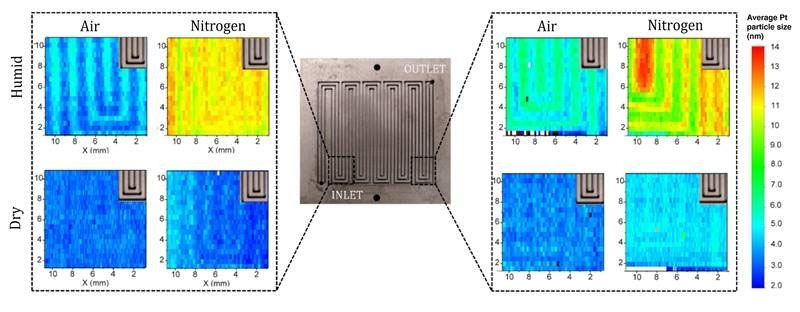| Jun 08, 2022 |
Fuel-cell waste reduction goes platinum
|
|
(Nanowerk News) Fuel cells generate electricity from hydrogen, a “clean” fuel that produces only water when burned. Platinum is a key catalyst in this process. However, platinum degrades unevenly in fuel cells, resulting in still-usable platinum being discarded when “worn out” fuel cells are replaced.
|
|
To improve fuel cell durability and reduce waste, this research (Advanced Energy Materials, "Probing Heterogeneous Degradation of Catalyst in PEM Fuel Cells under Realistic Automotive Conditions with Multi-Modal Techniques") studied the causes of uneven platinum degradation. These causes include the humidity and gas environment (air vs nitrogen) inside the fuel cells and the geometry of the fuel cell flow channels.
|
 |
| In fuel cells, hydrogen gas flows through channels in membranes coated with platinum catalyst. Platinum degradation (redder colors in insets) can be affected by the presence of other gases (air or nitrogen), humidity, and location (flow inlet vs. outlet). (Image: University of California, Irvine)
|
|
Polymer electrolyte fuel cells (PEFCs) are an attractive option for use in automobiles because they are compact and can quickly ramp up power output as needed. Lower cost and greater durability would encourage their wider use.
|
|
For light-duty vehicles, precious-metal catalysts such as platinum can account for about a third of the cost of PEFCs. In this study, scientists studied patterns in the deterioration of platinum catalyst in PEFCs. The results led to simple, effective strategies to reduce the waste of precious catalyst material.
|
|
A team led by the University of California, Irvine and Bosch studied commercially available catalyst-coated membranes that were subjected to accelerated stress testing. They performed tests under humid and dry conditions and in air and nitrogen environments. Their analysis of the samples involved a variety of methods, including scanning electron microscopy and several X-ray spectroscopy techniques.
|
|
At the Advanced Light Source (ALS), a Department of Energy (DOE) user facility, the scientists used X-ray diffraction to map the sizes of the aged platinum nanoparticles (larger particles indicate greater degradation). They also used X-ray computed tomography to image the catalyst layers after aging.
|
|
The results revealed that platinum ages faster near flow-field outlets, as well as in nitrogen environments and in higher humidity. Aging was also accelerated in the spaces between the maze-like channels that guide hydrogen gas through the catalyst layer, an effect that disappeared for narrower flow-field dimensions.
|
|
The study concluded that the addition of counter-flow channels could help reduce inlet/outlet variability, and that higher-temperature operation could help maintain lower relative humidity. PEFC vehicles are an excellent emission-free alternative to fossil-fuel vehicles.
|
|
The results from this study can aid in the development of immediate system-level strategies to increase durability and reduce costs until alternate, lower-cost catalyst materials are found for this technology.
|

